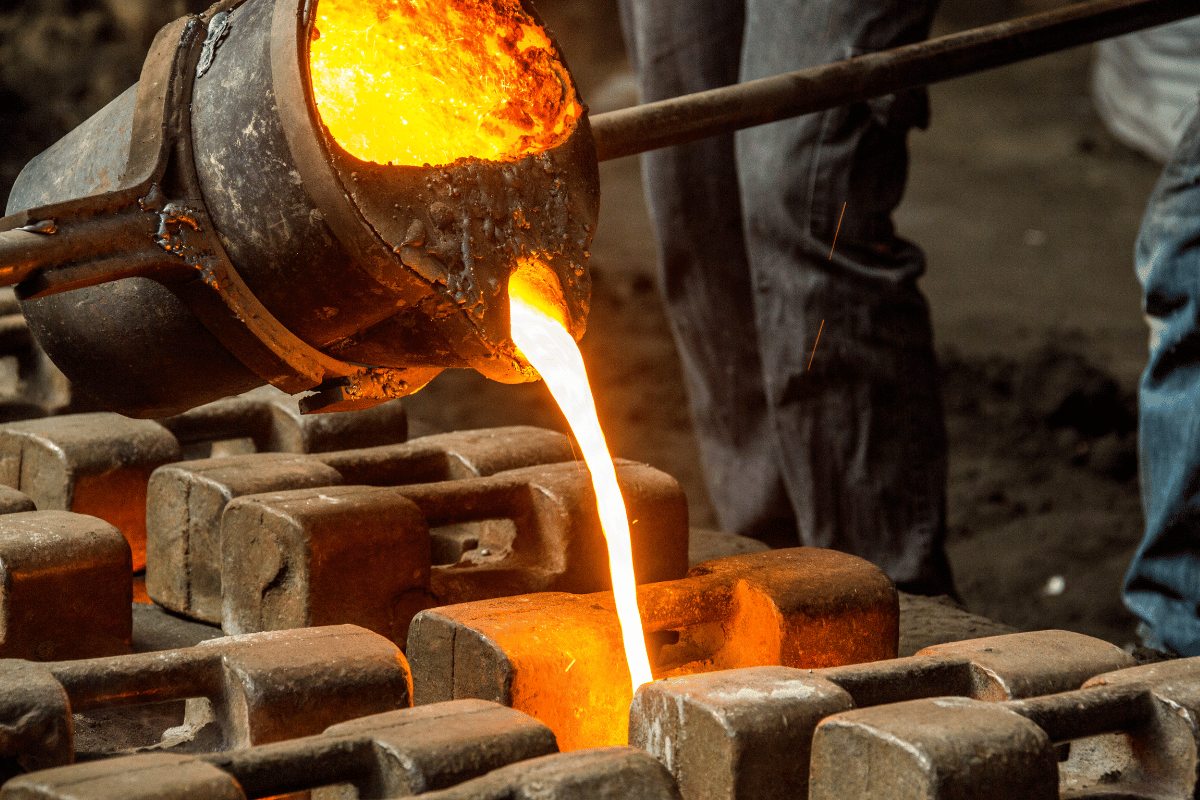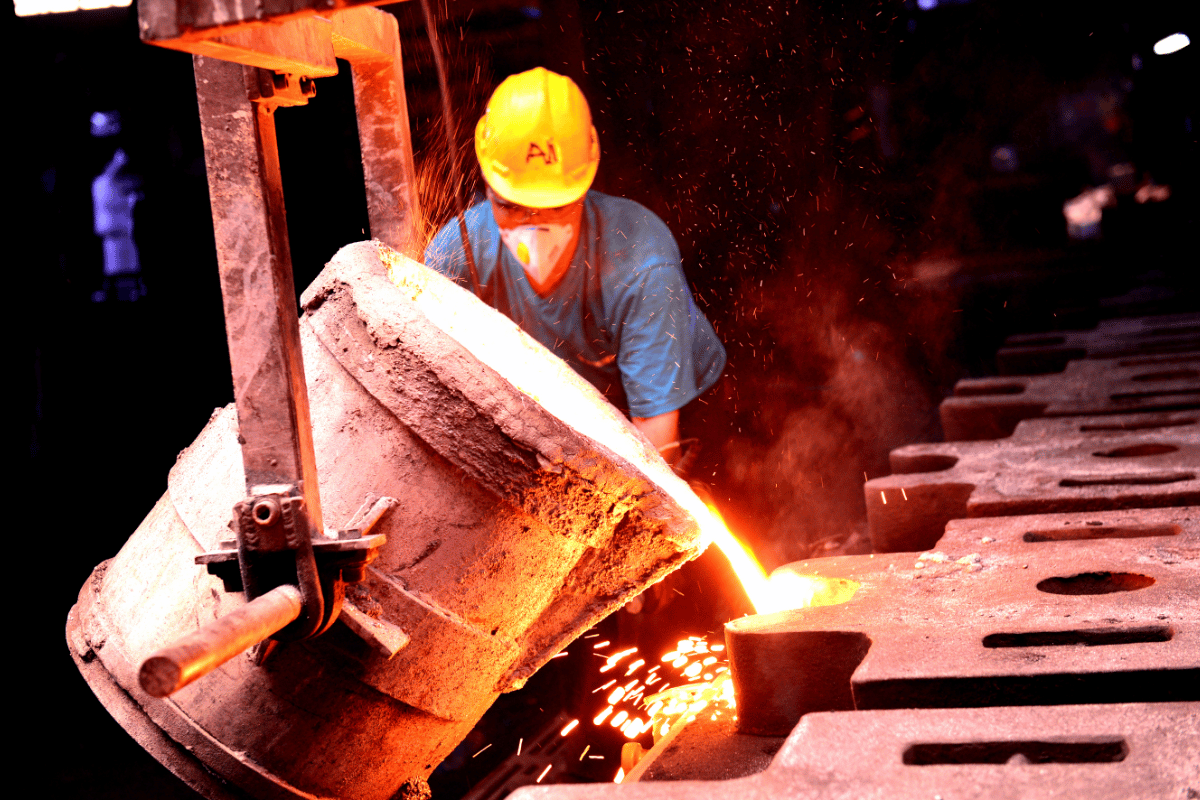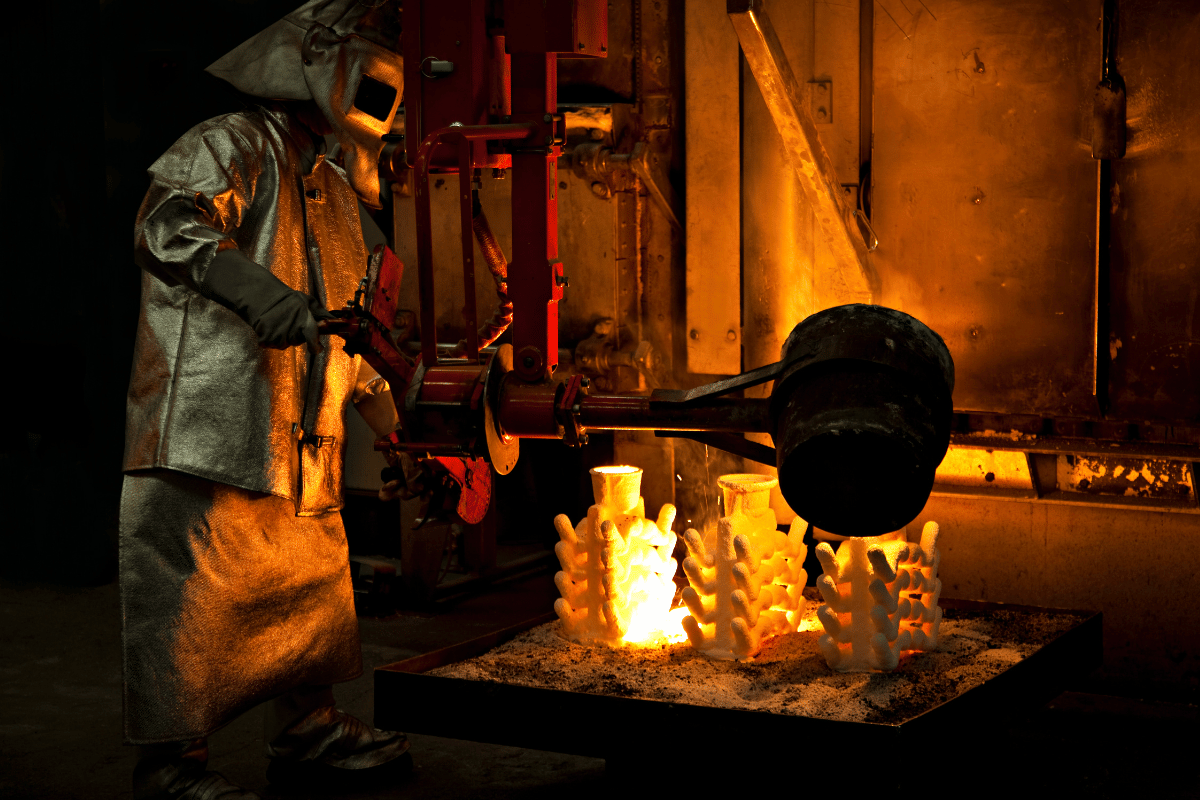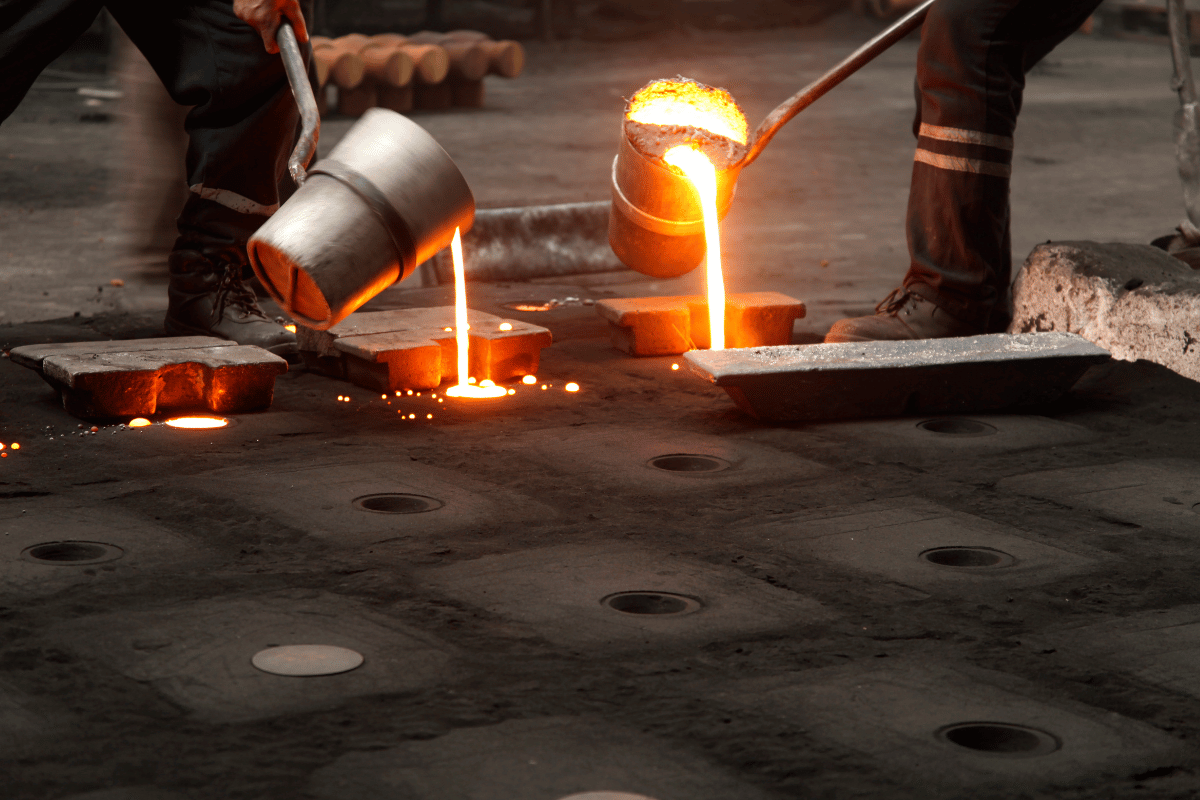From the time of early civilizations, the art of metal casting has been the cornerstone of human development, acting as a bridge between epochs and civilizations. This age-old technique, with its roots buried deep within human history, is more relevant today than ever before, with its echoes resonating throughout modern industry.
A brief foray into the annals of time reveals that metal casting was indispensable for creating tools, weapons, ornaments, and countless artifacts that played pivotal roles in the evolution of societies. The ancient Egyptians utilized it for crafting gold jewelry, while the Chinese mastered the bronze casting techniques for their statues and bells. Yet, these historical footnotes are not just tales of bygone eras but testament to the enduring legacy of this craft.
Fast forward to today’s industrialized world, and you’ll realize that the significance of metal casting has not waned but, in fact, amplified. Whether it’s the automotive sector churning out millions of vehicles, aerospace companies reaching for the stars, or the construction industry shaping our cityscapes – all owe a debt to the sophisticated metal casting investment techniques that have continuously evolved.
The rebirth and growing preeminence of metal casting in contemporary industry are no accident. It’s a confluence of its inherent capabilities, amalgamated with technological advancements and the relentless demands of an ever-hungry market. As we embark on this exploration into the realm of metal casting investment, it’s essential to grasp its historical profundity, the pivotal role it plays today, and its potential to shape the future of human endeavors.
The Rising Popularity of Metal Casting in the Modern Market
The global marketplace has always been dynamic, shaped by economic fluctuations, technological breakthroughs, and societal needs. Today, the renewed interest and reliance on metal casting epitomize how traditional methods can seamlessly mesh with modern requirements, resulting in a renaissance of sorts for this age-old industry.
One of the most telling indicators of the resurgence of metal casting is the economic growth experienced by numerous nations. With industrialization taking center stage in developing economies, there has been an insatiable demand for metal products, from infrastructure components to machinery parts. This surge isn’t solely confined to emerging economies; mature markets too are witnessing a reinvigorated demand, as sectors like aerospace, automotive, and defense continuously seek precision-cast parts.
Driving this trend further is the influx of innovations. The metal casting investment landscape today is starkly different from what it was a decade ago. Advances in computational capabilities have birthed more efficient casting simulations, ensuring enhanced accuracy and minimal wastage. Furthermore, new alloys with superior properties are continually being developed, opening up possibilities in applications that were previously deemed unfeasible.
Another facet that has amplified the appeal of metal casting is the blossoming of startups and enterprises that bank on bespoke solutions. The present-day market, characterized by customization and niche demands, is ripe for businesses that offer specialized casting services. This shift from mass production to mass customization is a testament to the industry’s adaptability and its readiness to cater to the market’s ever-evolving needs.
Moreover, the role of metal casting investment cannot be understated in today’s sustainability-driven world. With environmental concerns taking precedence, there is a concerted push towards processes and products that are not only efficient but also environmentally benign. Investment in cleaner casting techniques and the adoption of recycled materials underline the industry’s commitment to a greener tomorrow.
In conclusion, the modern market’s affinity for metal casting isn’t a mere trend or a fleeting phase. It’s an acknowledgment of the industry’s inherent strengths, coupled with its adaptability to incorporate innovations, making it an indispensable cog in the global industrial machinery.

Why Entrepreneurs are Looking Towards Metal Casting Investment
In the vast tapestry of business opportunities, metal casting investment stands out, not as a shiny new venture, but as a goldmine with proven reserves. Entrepreneurs, with their innate ability to identify profitable niches, are increasingly gravitating towards this sector. But what exactly is drawing them to this age-old industry?
Profit Potential in the Sector: One cannot understate the sheer scale of demand for cast metal products. From automotive components to construction equipment, the spectrum of applications is vast. Coupled with innovations in casting techniques and alloys, this has opened up a plethora of avenues for creating high-margin products. The increasing demand for precision-cast components, especially in industries like aerospace and healthcare, presents a lucrative opportunity for those willing to invest in advanced casting techniques.
Untapped Opportunities and Market Gaps: While many might perceive metal casting as a saturated market, given its age and prominence, the reality is quite contrary. Several niches within the casting domain remain underexplored. Specialized casting for sectors like renewable energy, niche automotive applications, and bespoke art installations are just a few areas where entrepreneurial minds can carve out a unique space. Furthermore, with the global market becoming more intertwined, there are numerous geographic regions where the demand for cast metals far outstrips local supply.
Flexibility of Scale: One of the alluring aspects of metal casting investment is the flexibility it offers. Entrepreneurs don’t necessarily have to invest heavily from the outset. Starting with a modest setup, focusing on specific niches, and then scaling up as demand grows is a feasible strategy. This incremental growth approach minimizes risk while maximizing returns.
Integration with Modern Technologies: The metal casting sector isn’t confined to its traditional roots. Today, it stands at the intersection of age-old techniques and modern tech innovations. Entrepreneurs can leverage technologies like AI-driven casting simulations, 3D printing for mold creation, and IoT for real-time monitoring, turning a traditional casting setup into a state-of-the-art facility.
Sustainability and Green Initiatives: With the world moving towards sustainable practices, there’s a growing demand for eco-friendly casting processes. Entrepreneurs focusing on recycling initiatives or adopting energy-efficient casting methods stand to benefit from both profitability and positive branding. Emphasizing green practices can be a significant differentiator in a competitive market.
In summation, while metal casting might seem like a vestige from a bygone era to the untrained eye, it presents a mosaic of opportunities for the discerning entrepreneur. The combination of proven demand, the promise of innovations, and the allure of untapped niches makes metal casting investment a compelling proposition in the modern entrepreneurial landscape.

Advancements in Metal Casting Technologies
In a world that is constantly evolving, where technological strides redefine industries overnight, metal casting stands tall, amalgamating tradition with innovation. This sector, with roots tracing back millennia, is now reinvigorated with breakthroughs that cater to the exacting demands of today’s world. Let’s explore the cutting-edge advancements reshaping the landscape of metal casting.
New Materials and Processes: As industries push the boundaries of what’s possible, the need for materials with distinct properties has become paramount. Alloys with high tensile strength, exceptional corrosion resistance, or specific conductivity attributes are now achievable. Metallurgical innovations have given rise to superalloys, capable of withstanding extreme conditions, finding applications in sectors like aerospace and deep-sea exploration. Concurrently, the development of processes like vacuum casting and centrifugal casting offers precision and reduces material wastage.
Automation and Digitization in Casting: The era of Industry 4.0 has left no stone unturned, and metal casting is no exception. Robotic arms, equipped with sensors, now handle tasks that were traditionally labor-intensive, ensuring consistency and precision. AI-driven software optimizes mold designs, predicting potential flaws, and offering corrections even before the first prototype is cast. Furthermore, the Internet of Things (IoT) facilitates real-time monitoring of casting processes, ensuring optimal operating conditions and immediate troubleshooting, enhancing both efficiency and product quality.
3D Printing and Rapid Prototyping: One of the most transformative technologies, 3D printing, has found its footing in metal casting investment. It allows for rapid prototyping, enabling manufacturers to test designs without committing to full-scale production. Beyond prototyping, 3D printing of sand molds for casting has become a game-changer, especially for intricate designs that would be challenging to achieve through traditional methods.
Computational Fluid Dynamics (CFD): This numerical tool, which analyzes fluid flow, heat transfer, and related phenomena, has emerged as a critical asset in metal casting. Through CFD, experts can simulate the flow of molten metal, anticipate potential defects, and adjust parameters accordingly, resulting in casts that meet stringent quality standards.
Environmentally-friendly Casting: With sustainability becoming a global clarion call, innovations in eco-friendly casting are gaining traction. Techniques that minimize emissions, reduce energy consumption, and utilize recycled materials underscore the industry’s commitment to a greener future.
In essence, the confluence of technological advancements in metal casting represents a renaissance of sorts. While the core principles remain steadfast, the tools, techniques, and materials have evolved, making metal casting more efficient, precise, and in tune with contemporary requirements.

Environmental Considerations and Sustainable Casting
The march of progress has often been at loggerheads with environmental considerations. As industries burgeoned, nature sometimes bore the brunt. However, a new consciousness is emerging, one where productivity and eco-responsibility coalesce. The metal casting domain is no stranger to this evolution. Recognizing its responsibility, the industry is pioneering initiatives that prioritize sustainability without undermining efficiency.
Eco-friendly Casting Processes and Materials: At the forefront of sustainable advancements is the development and adoption of greener casting processes. Bio-based binders, replacing traditional chemical binders, reduce the emission of volatile organic compounds during the casting process. Moreover, the industry is veering towards non-ferrous metals that require lower melting temperatures, resulting in significant energy savings.
The Role of Recycling in Metal Casting: Metals, by their very nature, are recyclable. Metal casting investment in recycling has multiple dividends. It reduces the need for raw material extraction, conserving natural resources, and minimizing environmental disruption. Furthermore, recycling old metal components consumes substantially less energy than processing raw ores. Many foundries have integrated recycling into their operations, ensuring that waste metal finds its way back into production rather than landfills.
Waste Management and Reduction: Modern casting facilities emphasize a circular economy approach. Efforts are channeled to ensure that waste, whether it’s slag, dust, or sand from molds, is either recycled or disposed of with minimal environmental impact. Techniques like sand reclamation allow foundries to reuse sand for mold-making, substantially reducing the need for new sand and the associated environmental extraction costs.
Energy-efficient Equipment and Processes: The shift towards energy-efficient machinery in metal casting is palpable. Induction furnaces, which use electromagnetic fields to melt metals, are rapidly replacing traditional methods due to their higher energy efficiency and lower emissions. Moreover, optimization software aids foundries in determining the most energy-efficient operational parameters, ensuring minimal energy wastage.
Water Conservation: Water is an invaluable resource, and its judicious use in the casting industry is becoming a focal point. Closed-loop water systems, where water is recycled and reused within the facility, drastically reduce water consumption. Any wastewater generated undergoes treatment to remove contaminants, ensuring that it doesn’t adversely impact aquatic ecosystems.
Monitoring and Reporting: Adherence to environmental standards is not just a moral imperative but a legal one. Foundries today invest in sophisticated monitoring equipment that continually assesses emission levels, ensuring compliance with stringent environmental regulations. Regular audits and transparent reporting underscore the industry’s commitment to ecological stewardship.
In conclusion, the narrative of metal casting in the context of environmental considerations is an optimistic one. A sector once associated with belching furnaces and towering slag heaps has metamorphosed, embracing practices that signify respect for the planet. Sustainable casting is not just a buzzword; it’s an actionable commitment, heralding a brighter, greener future.

Challenges Faced by Entrepreneurs in Metal Casting
Metal casting, an industry anchored in ancient civilizations, may seem alluring with its blend of tradition and innovation. While the potential for profitability and contribution to the industrial world is substantial, the path is riddled with challenges. Entrepreneurs diving into the metal casting investment landscape must be well-versed with these hurdles to navigate them effectively.
Economic Barriers to Entry: One of the most glaring challenges for budding entrepreneurs is the capital-intensive nature of the industry. Establishing a foundry requires significant investments in machinery, facilities, raw materials, and skilled labor. Moreover, ensuring that the foundry is compliant with environmental regulations can further escalate setup costs. This financial barrier often deters many potential entrants, especially those without substantial backing or external funding.
Technological Challenges and Skill Requirements: The marriage of tradition and technology in metal casting means that entrepreneurs need expertise in both arenas. Investing in the latest technology is not enough; understanding its integration and ensuring that the workforce is adequately trained is vital. Additionally, the industry is witnessing rapid technological advancements. Staying updated and continually investing in training and machinery upgrades can be both challenging and expensive.
Competition and Market Saturation: As with many industries showing promise, the metal casting sector is becoming increasingly saturated. Established foundries with years, if not decades, of experience, have a significant advantage in terms of reputation, clientele, and operational efficiency. New entrants must find a unique value proposition to differentiate themselves and capture a segment of the market.
Supply Chain Vulnerabilities: A robust supply chain is the backbone of any manufacturing industry. Fluctuations in raw material prices, transportation hiccups, or geopolitical tensions can disrupt the supply chain, affecting production timelines and profitability. Entrepreneurs must develop contingency plans and foster strong relationships with multiple suppliers to mitigate such risks.
Environmental and Regulatory Compliance: As highlighted earlier, the industry’s focus on sustainability and environmental protection has led to stringent regulations. Adhering to these norms is non-negotiable and often demands additional investments in terms of equipment, processes, and audits. Navigating this regulatory maze, while essential, can be daunting for newcomers.
Quality Assurance and Reputation Building: The end product’s quality is paramount. Any defects or inconsistencies can lead to a loss of clientele and a tarnished reputation. Implementing rigorous quality control measures from day one is crucial. Moreover, building a brand reputation in an industry dominated by legacy players requires strategic marketing, exceptional quality assurance, and consistent customer engagement.
In sum, while the allure of the metal casting domain is undeniable, it’s a field laden with challenges that demand a blend of strategic planning, financial acumen, and industry expertise. However, for those who navigate these challenges effectively, the rewards — both in terms of financial returns and industry impact — can be substantial.

Case Studies: Successful Entrepreneurial Ventures in Metal Casting
The metal casting industry, while replete with challenges, has also witnessed numerous success stories. Entrepreneurs, with their drive and innovative spirit, have carved out niches, brought fresh perspectives, and rejuvenated traditional methods. Below are some noteworthy ventures that have thrived in the landscape of metal casting investment.
1. AlloyTech Foundry: Embracing Technology AlloyTech, established in the early 2000s, identified a gap in the market for high-precision casting components for the aerospace and automotive sectors. They invested heavily in cutting-edge technologies, integrating 3D printing into the mold creation process. This not only reduced the time taken for prototype development but also ensured higher precision. Their commitment to technology and a well-defined niche quickly positioned them as industry leaders in their segment.
2. GreenCast: Pioneering Sustainability In a bid to address the environmental concerns of metal casting, GreenCast was launched with a mission to be the most eco-friendly foundry in the region. They pioneered processes that used up to 50% recycled materials without compromising product quality. Their waste management and emission control systems set new industry benchmarks, earning them several green certifications and a loyal clientele base that prioritized sustainability.
3. CastTech Innovations: Bridging Tradition and Modernity Originating from a family with generations rooted in traditional casting methods, the founders of CastTech aimed to marry age-old techniques with modern technology. They retained the artisanal approach for designs while automating repetitive tasks. This blend resonated with clients seeking unique, handcrafted components with the efficiency of modern production methods.
4. MetaFlow Industries: Overcoming Supply Chain Hurdles MetaFlow’s inception was driven by an intention to streamline the often erratic supply chain associated with metal casting. By integrating raw material sourcing, processing, and distribution under one umbrella, they offered clients a one-stop solution, drastically reducing lead times and ensuring cost-effectiveness. Their integrated approach soon became a major USP, attracting a broad spectrum of clients.
5. ForgeAhead Solutions: Specializing in Custom Solutions Rather than targeting bulk orders, ForgeAhead positioned itself as a boutique foundry, specializing in customized casting solutions for clients with specific needs. Their consultative approach, coupled with an agile production methodology, allowed them to cater to bespoke requirements, from art installations to specialized machinery components.
These case studies underscore that success in the metal casting sector isn’t solely dependent on hefty investments or large-scale operations. Vision, a keen understanding of market gaps, the agility to adapt, and a commitment to excellence are attributes that have driven these entrepreneurial ventures to prominence. Each of these businesses offers lessons in resilience, innovation, and strategic planning, illuminating the path for future entrepreneurs in the sector.

Future Outlook: Predictions for the Next Decade in Metal Casting Investment
The metal casting sector is on the precipice of a transformative era. With advancements in technology, changing market dynamics, and a stronger emphasis on sustainability, it’s poised to undergo significant evolution in the coming decade. Let’s delve into some informed predictions for the future landscape of metal casting investment.
1. Rise of Smart Foundries: The concept of ‘smart factories’ or ‘Industry 4.0’ will permeate the metal casting domain. These foundries will leverage AI, IoT, and real-time data analytics to enhance production efficiency, minimize waste, and optimize resource usage. With interconnected machinery and systems, predictive maintenance will reduce downtimes, while automated quality checks will ensure consistent product standards.
2. Green Casting will Gain Traction: Environmental considerations, which are already gaining momentum, will dominate the industry’s ethos. Eco-friendly casting processes, increased use of recycled materials, and energy-efficient machinery will become standard. Foundries that fail to adapt to these green standards may risk obsolescence or face regulatory challenges.
3. Diversified Material Portfolio: Though traditional metals will continue to be prominent, there will be a surge in the demand for new alloys, composites, and bio-derived materials. These materials will cater to specific industry needs, such as lightweight components for aerospace or corrosion-resistant parts for marine applications.
4. Customization will Reign Supreme: As observed with ForgeAhead Solutions, the demand for bespoke solutions will rise. With advancements in 3D printing and rapid prototyping, foundries will be better equipped to cater to niche markets and specialized requirements, offering clients unparalleled design flexibility.
5. Investment in R&D will be Crucial: Foundries that prioritize research and development will have a competitive edge. New casting techniques, material innovations, and process optimizations will stem from dedicated R&D efforts. Collaboration with academic institutions and tech startups will further foster innovation in the sector.
6. Global Supply Chain Realignment: With geopolitical shifts, trade dynamics, and the lessons learned from global crises like the COVID-19 pandemic, there will be a marked emphasis on diversifying supply chains. Foundries will seek to establish partnerships across various regions, ensuring business continuity and risk mitigation.
7. Upskilling and Reskilling Workforce: As the industry leans more towards technology and automation, the need for a skilled workforce will be paramount. Continuous training programs, apprenticeships, and collaborations with tech institutions will ensure the workforce remains abreast of the latest industry developments.
In conclusion, the next decade in metal casting investment is set to be a vibrant blend of tradition and innovation. Foundries will not only preserve the age-old techniques that have stood the test of time but will also embrace the myriad opportunities that modern technology and market dynamics present. Those willing to invest, innovate, and adapt will undoubtedly shape the future of this age-old industry, ensuring its relevance and vitality in a rapidly evolving global economy.
Metal casting investment has long been the bedrock of numerous industries, serving as the very foundation upon which countless technological advancements and infrastructural developments have been built. As we’ve journeyed through the historical intricacies, contemporary allure, and forward-looking potential of this domain, it’s evident that metal casting’s significance is not waning; rather, it’s evolving in response to the demands of our times.
The age-old techniques that have been perfected over millennia now work hand-in-hand with cutting-edge technologies and innovations. From the sustainable practices that seek to protect our planet, to the digital revolution within foundries, the world of metal casting is responding dynamically to contemporary challenges and opportunities.
For entrepreneurs, the realm of metal casting investment represents a landscape rich with potential. There are untapped markets to penetrate, innovative technologies to harness, and green initiatives to lead. However, with vast potential also comes a series of challenges. The intricate dance of balancing traditional know-how with modern demands, of addressing environmental concerns while ensuring profitability, and of navigating the evolving global supply chain is no simple feat.
Yet, history has shown us that this industry is resilient. It has weathered countless storms, adapted to myriad changes, and continuously emerged stronger, more refined, and more integral to the world’s progress. As we stand at the threshold of a new era for metal casting, it’s not just about the metals that are molded but about the mettle of those who venture into this domain.
For those willing to embrace the evolving dynamics, invest in research and innovation, and champion sustainable practices, the future promises not only profitability but also the profound satisfaction of contributing to an industry that quite literally shapes the world.
In the years to come, metal casting investment will undoubtedly continue its legacy of being a pillar of strength, innovation, and growth. As we’ve reiterated throughout, the sector is not just about pouring molten metal into molds; it’s about crafting the future, one cast at a time.
References and Further Reading:
- Smith, J. (2018). Metal Casting: A Historical Perspective. London: Industry Press.
- Patel, R. (2020). Sustainable Casting: Eco-Friendly Practices in Modern Foundries. New York: GreenTech Publications.
- Liu, W. (2021). Digital Transformation in Metal Casting. Beijing: TechForward Publishers.
